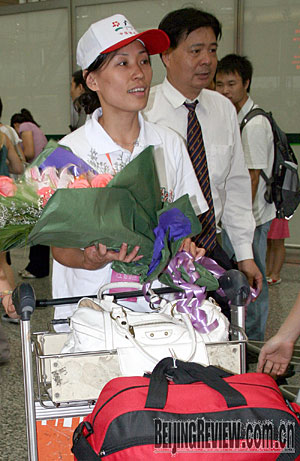|

HISTORIC TRIP: The first mainland travel tour group to Taiwan returns to the Baiyun Airport, Guangzhou on July 13 (DU JUAN)
The Mid-Autumn Festival, which fell on September 14 this year, is traditionally a time for family reunions. To help maintain tradition, from September 7 to 21, eight airlines operated 16 charter flights between Shanghai and Taipei, and between Xiamen and Taipei, to bring together families living on different sides of the Taiwan Straits, according to the China Civil Aviation Administration.
In addition to the festival charter flights, since July 18 people can commute between the mainland and Taiwan on weekend charter flights. The weekend charter flights were launched after the resumption of talks between the mainland-based Association for Relations Across the Taiwan Straits (ARATS) and the Taiwan-based Straits Exchange Foundation (SEF).
ARATS and SEF are two associations that have played an important role in facilitating cross-straits relations. After a decade-long hiatus, the two associations recently resumed talks, and agreed to launch the weekend charter flights, which marks a new step toward the goal of "three links"-that is, direct cross-straits links for mail, trade and transport services. The "three links" have always been a major policy goal for the mainland, and they are the avid wish of people on both sides of the Taiwan Straits.
The history of the "three links"
The "three links" concept originated in the National People's Congress (NPC) Standing Committee Message to Compatriots in Taiwan, released in January 1979. The document said, "We hope that at an earlier date transportation and postal services between both sides will be established" and "there is every reason for us to develop trade between us, each making up what the other lacks, and carry out economic exchanges."
On September 30, 1981, Ye Jianying, Chairman of the NPC Standing Committee, first clearly defined the "three links" as direct mail, trade and transport services. Direct transport services are the core of the "three links." Since then, the mainland has actively pushed for the "three links" and relevant departments and businesses have conducted many rounds of consultations.
Significant progresses have been made toward achieving the "three links." The first step was establishing "three mini links" that are direct economic and trade links between the coastal area of Fujian Province in the mainland and the three islands of Penghu, Kinmen and Matsu in Taiwan. Since 2001, passenger and cargo ships have shuttled regularly between Xiamen and Kinmen, Mawei and Matsu and Quanzhou and Kinmen, transporting more than 3 million passengers in all. There have also been irregular cargo flights between Meizhou, Guangdong Province and Kinmen.
| 